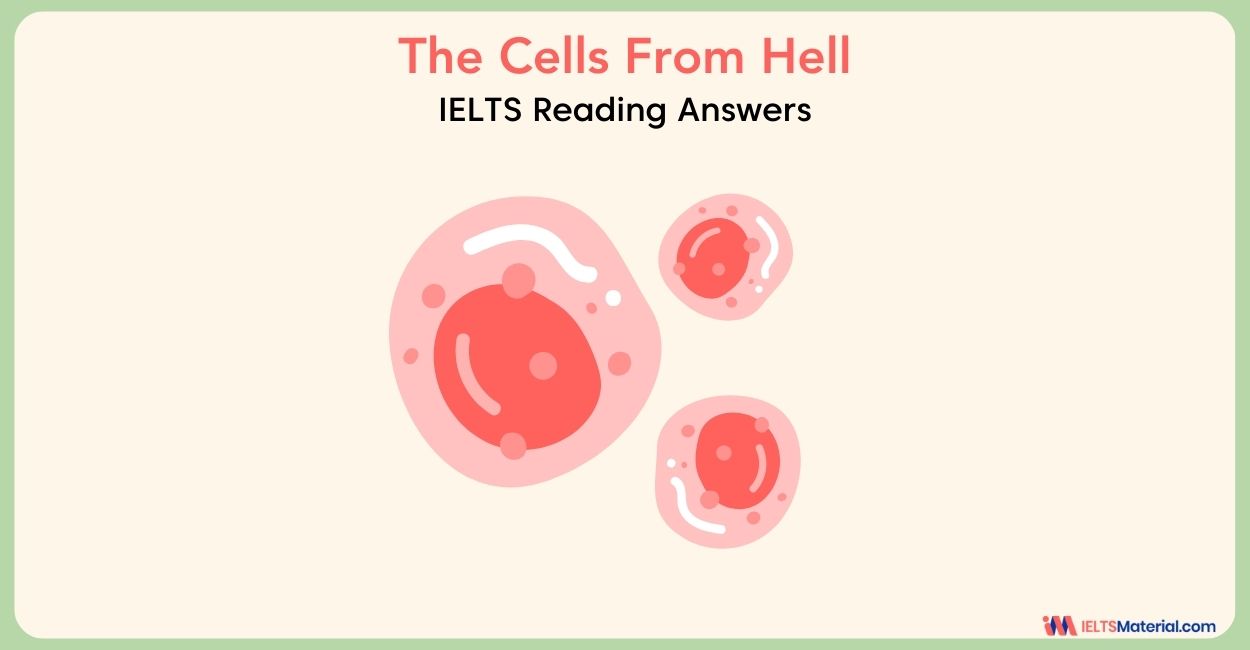The Cells From Hell Reading Answers
4 min read
Updated On
-
Copy link
Table of Contents

Limited-Time Offer : Access a FREE 10-Day IELTS Study Plan!
The IELTS Academic Passage, “The Cells From Hell”, is a real IELTS Reading test passage from past papers. You can practice by taking the test now and also check The Cells From Hell reading answers below. This will help you understand the questions and how they paraphrase the information from the passage.
With diligent practice, the Reading Module can be the top-scoring category for IELTS Aspirants. To score well, you must understand how to approach and answer the different question types in the Reading Module.
By solving and reviewing Sample Reading Questions from past IELTS papers, you can ensure that your Reading skills are up to the mark. You can also try more IELTS reading practice tests.
Not sure how to answer Summary Completion questions? Check out IELTS Reading Summary Completion – Lessons, Tips.
The Cells From Hell
You should spend about 20 minutes on Questions 14-26, which are based on the Reading Passage below.
Find the practice test with The Cells From Hell PDF here.
Answers
| Question number | Answer | Explanation |
|---|---|---|
| 14 | plant | In paragraph 5, there’s a line that mentions, “in tanks, Pfiesteria was quite content to behave like a plant and photosynthesize.” The term ‘behave like a plant’ can be interpreted as ‘act like a plant.’ Hence, the correct answer is “plant.” |
| 15 | poisons | Paragraph 3 states that “to deter fish from swallowing them, some have evolved powerful toxins.” The phrase ‘evolved powerful toxins’ can be understood as ‘powerfully developed poisons.’ Hence, the correct answer is “poisons.” |
| 16 | eats | Paragraph 5 implies that “Pfiesteria changed shape again and devoured them.” Since Pfiesteria switches to attack modes, and the term devoured means to eat, it hints that Pfiesterias are the organisms that eat fish. Hence, the correct answer is “eats.” |
| 17 | disappears | According to paragraph 5, “Pfiesteria changed shape again and devoured them. When it had its fill, it vanished. No one had ever seen an organism do this.” The term ‘vanished’ means ‘disappears.’ It implies that it disappeared afterward. Hence, the correct answer is “disappears.” |
| 18 | pollution | Paragraph 6 mentions that “it seemed pollution was to blame. When the water containing the biggest fish kills was analyzed, scientists found high levels of pollution.” From this line, we can deduce that scientists have found a high level of pollution that caused the killing. Hence, the correct answer is “pollution.” |
| 19 | Large numbers of | Paragraph 6 conveys that “include large numbers of fish travelling together which feed in poorly flushed places with a lot of algae to eat and other rich food sources.” This line signifies that ‘biggest fish kills’ implies referring to a large number of fish feeding together. Hence, the correct answer is “large number of.” |
| 20 | New kind of | As per paragraph 7 “they heard about new kinds of toxins and discussed possible links between algae and whale standings.” From the above line, we can deduce that researchers heard or learned about the new kind of toxins. Hence, the correct answer is “new kind of.” |
| 21 | Carried by ship | The last line of paragraph 7 states that “what dominated the proceedings was news that toxic algae are spreading the new shores in ballast water carried by ships.” The words’ spreading the new shores in ballast water carried by ships’ implies that algae is spreading around the world via water carried by the ships. Hence, the correct answer is “carried by ship.” |
| 22 | C | Paragraph 7 discusses that “in the last decade these algal blooms* have poisoned sea-lions in California, caused catastrophic fish kills in the Pacific.” This line signifies that sea lines in California were poisoned and killed. Since it is not mentioned what poisoned them, we can infer that an unidentified microorganism killed them. Hence, the correct answer is “C.” |
| 23 | B | The last line of paragraph 8 mentions that “the same chattonella killed half a billion dollars’ worth of fish in Japan in 1972.” This line confirms that Chattonella killed fishes in Japan. Hence, the correct answer is “B.” |
| 24 | C | In paragraph 7, there’s a line that mentions that “in the last decade these algal blooms* have poisoned sea-lions in California, caused catastrophic fish kills in the Pacific. The Mediterranean and the North Sea, and devastated the shellfish industry in New Zealand.” Therefore, the shellfish industry loss was caused by an unidentified micro-organism in New Zealand. Hence, the correct answer is “C.” |
| 25 | B | The beginning of paragraph 9 states that “this toxin was also present in the livers of the dead tuna.” Since chattonella is the algae, it implies that chattonella caused tuna industry losses in Australia. Hence, the correct answer is “B.” |
| 26 | A | The initial lines of paragraph 2 convey that “on the eastern coast of the United States, began complaining about mysterious fish kills.” Since Pfiesteria is associated with fish kills, it signifies that Pfiesteria caused the mysterious fish kill in North Carolina. Hence, the correct answer is “A.” |
Check More IELTS Reading Answers
Also check :
Practice IELTS Reading based on question types

Start Preparing for IELTS: Get Your 10-Day Study Plan Today!
Recent Articles

Nehasri Ravishenbagam

Haniya Yashfeen

Haniya Yashfeen

Haniya Yashfeen




Post your Comments